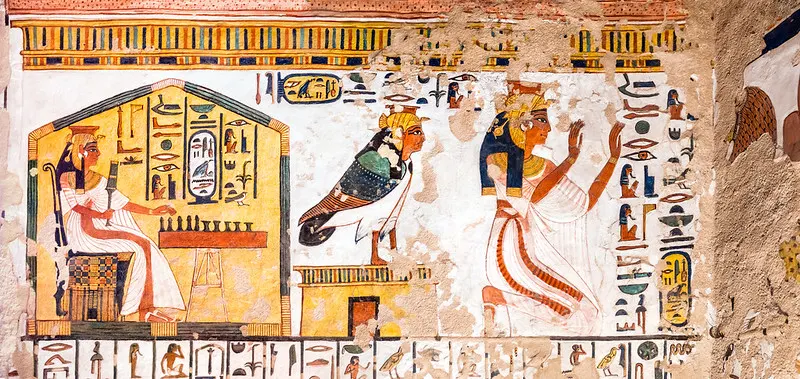The cyclical nature of the resurrection of Osiris and Nefertari

The cyclical nature of the resurrection of Osiris and Nefertari
Resurrection of Osiris/Nefertari
Cyclic characteristics The change from the north-south orientation of the Djoser to the east west orientation of the pyramids from the early Fourth Dynasty onwards shows that the cyclic nature of the astral planes coexists with the Osiris and solar regeneration modes in the pyramid texts but is subordinate to the solar-solar cycle pattern The posthumous existence of the three deceased kings
Tomb of Nefertari, QV66, Valley of the Queens
wall eastern / Between her and the god is a large and bountiful pile of offerings, on top of which are several bowls emitting smoke. The offerings are heaped on three reed mats, with large animal carcasses on the bottom two and smaller offerings on the top one.
The pyramid texts provide clear written evidence that, at least as far back as the Fifth Dynasty the deceased pharaoh was automatically equated with both the Sun God11 and Osiris12 according to his royal status and is believed to have experienced a mode of renewal and regeneration consistent with that of the pyramid texts of Neith. Neith an ancient Egyptian goddess is symbolized by two crossed arrows and cyclical femininity and the texts refer to her as the mother of the gods growing in time like the female Sun God and one of four goddesses guarding the burial and limbs of the deceased Wedjebten, the wife of Pepy II of the Sixth Dynasty asserts that deceased Egyptian queens were associated with the Sun God and Osiris and that their titles were Osiris as early as the late Sixth Dynasty
Tomb of Nefertari, QV66, Valley of the Queens the descent, upper west wall
Nefertari holds out two round nemset jars above an altar piled high with fruit, vegetables,
cuts of meat, and loaves of bread.The texts which surround her provide her identity and end with the usual symbols of "protection,
The analysis of the programs of two tombs in the Late Ancient Kingdom and one in the Middle Kingdom clearly shows an afterlife in Egypt as the three goddesses played for the sun god But the process by which women whether royal or pharaonic were resurrected is not clear although the association of dead women with Osiris and the sun god from the Ancient Kingdom onwards there is no cyclical character in which women have an afterlife
eastern annexe north wallNefertari stands in the middle of the north wall, in front of the seated god Thoth, with the head of an ibis.
The wife of Ramses II aware of the complexity of the conjugal form will elaborate on the multiple factors in this cycle of how Nefertari began her afterlife This is reflected in the paintings and sculptures in the ancient Egyptian temples namely Nefertari's postmortem regeneration She became both male and female a status that did not necessarily exist without Ramses II in Nefertari's tomb The cyclical use of masculine characteristics and the attainment of sexual status similar to Neth the cyclical femininity such as the Sun God may conflict with the feminine characteristics in this cyclical process Furthermore it will be shown that the mechanism of regeneration and renewal of the queen based on the assumption of the potential for male regeneration in harmony with Osiris and the Sun God is conveyed through the art in the tomb
Tomb of Nefertari, QV66, Valley of the Queens antechamber, west wall Here is Nefertari's mummified bo
dy flanked by the goddesses Nephthys and lsis; they appear protecting the queen.
Tomb of Nefertari, QV66, Valley of the Queens, antechamber east wall
On the left side of the wide entry to the next chamber is a representation of Osiris, standing in a shrine with a high arched roof. Osiris holds a crook and flail. On head are the atef-crown, based around the white crown of Upper Egypt and two plumes
This temple and the tomb of Nefertari are both well-preserved monuments dedicated to the same royal woman. Both monuments are valuable sources of information about the appropriateness in the context of both temple/cultural rituals the rules of the resurrection and the gender of women as a whole genderless without Ramses II in the temple of the incorporeal spouse in the decoration of the tomb as the most ancient Egyptian fertility in the cycle of death and rebirth as the queen of Egypt.
Heather Lee McCarthy / Heather McCarthy
Journal of the American Research Center in Egypt, Volume 39










